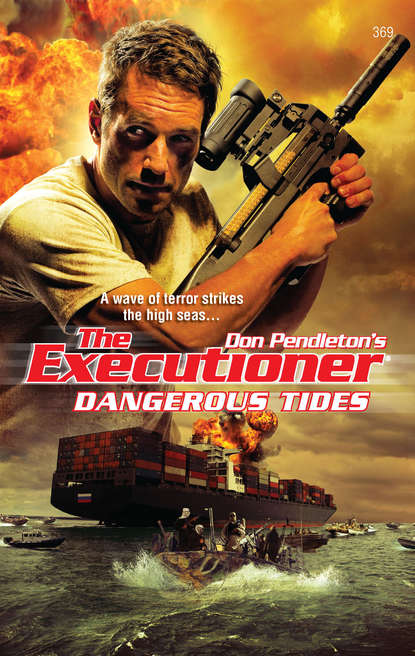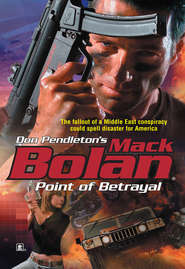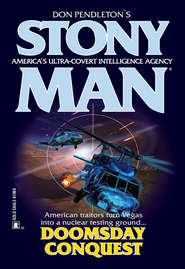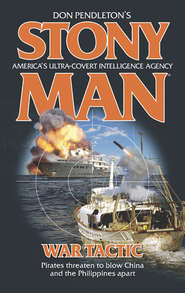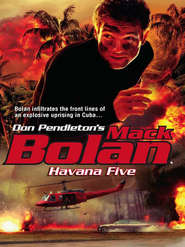По всем вопросам обращайтесь на: info@litportal.ru
(©) 2003-2024.
✖
Dangerous Tides
Автор
Год написания книги
2019
Настройки чтения
Размер шрифта
Высота строк
Поля
Behind him, in the open bay of the Seahawk, Mack Bolan lowered a pair of anti-fog goggles over his eyes. Then he checked the fit of the Boker Orca dive knife strapped to his thigh over his wet suit. He had already verified that the watertight pack strapped to the small of his back was double-buckled and secure. It was almost time to leave his headset—and Grimaldi’s chopper—behind.
“Understood, Jack,” he acknowledged, keying his own mike. “Final checklist.”
“Gear?” Grimaldi said.
“Secure.”
“Plumett case?”
The Executioner checked the seals on the heavy black case, then slung it over his shoulder and across his back.
“On board.”
“Air supply?” Grimaldi asked.
Bolan checked the fit of the mouthpiece on the modified pony bottle he wore on his chest. The bottle was fixed to one of the shoulder straps of his backpack, cinched tightly in place with nylon webbing. The small gauge on the high-tech bottle read Full.
“Check,” Bolan said.
“DPV?” Grimaldi ticked off.
Bolan reached down and switched on the standby power of the electric, self-contained Driver Propulsion Vehicle Stony Man Farm had provided for him. The muted status LEDs were all green. The mounted GPS locator displayed his position relative to his target coordinates. The DPV was a sealed electric motor with a single-use power supply, essentially a giant propeller cylinder and rudder assembly. Twin joysticks jutted above and behind, containing triggers to adjust the throttle and steer the unit.
“Ready,” Bolan said.
“Good luck, Sarge,” Grimaldi said. “And good hunting.” The cocky pilot turned all business as he watched his instruments. “On my mark, Striker,” he said, using Bolan’s Stony Man code name. “Five…four…three…two…one…mark.”
At Grimaldi’s signal, Bolan pulled off his headset and shoved the DPV out of the chopper, the twin sticks of the machine tight in his fists. He hit the water below like a stone. The heavy device pulled him beneath the roiling waves. He paused as he descended, orienting himself and taking air from the pony bottle, watching in the darkness as the GPS unit pointed the way to his destination.
Bolan thumbed the machine’s controls and held on tightly as the almost-silent device began pulling him rapidly through the water. He adjusted course with a few taps of the right-hand trigger, managing his depth by angling the DPV and his body with it.
Above him, Grimaldi would be piloting the Seahawk back to the Perry-class frigate James Richardson. The firepower available to Bolan and to Stony Man was considerable, but no amount of heavy weaponry could do the job that now faced him. No, to succeed, Bolan would have to use stealth, mounting a soft probe into enemy-held territory in order to liberate innocent men and women.
It was an all too common scenario for the Executioner.
Bolan had covered a lot of ground in the past several hours, first by jet, then by helicopter, then on the frigate, only to take to the skies once more to be dropped into the cold sea below. It had started with a single telephone call, routed to Bolan through channels from Washington by way of Stony Man Farm. The circuits connecting them were complex, but the scrambled phone briefing from Hal Brognola—speaking to Bolan from the big Fed’s Justice Department office in D.C.—had been straightforward enough.
“A cruise ship has been hijacked,” Brognola had said without preamble.
The natural assumption in the modern age was that yet another terrorist group was claiming responsibility for yet another act of violence against helpless men, women and children. Brognola quickly explained that the problem was, if anything, even more serious.
“What we have,” the big Fed said, “is an act of piracy.”
“Pirates?” Bolan had not been sure he’d heard correctly.
“It’s a growing and very serious issue in certain parts of the world,” Brognola said. “As you know, pirate attacks off the cost of Africa have surged, cutting off aid to countries like Somalia. The South China Sea alone, which sees a third of worldwide commercial shipping, sees about half of the pirate attacks recorded by the International Maritime Bureau every year. We’re talking about a cost to cargo insurers upwards of a hundred million U.S. dollars a year.”
“Big business,” Bolan agreed.
“And getting worse,” Brognola said. “It’s not just Africa and other backwaters. Nobody’s immune.” He paused. “Our friends the Chinese executed over a dozen Chinese pirates not too long ago, after convicting them of murdering the crew of a freighter near Hong Kong waters. Without doubt, however, the worst pirate activity is in Indonesia. Malaysia, Singapore and Indonesia all patrol the Malacca Strait,” Brognola went on, “which is one of the world’s busiest shipping lanes. But they can’t be everywhere.”
“What’s the profile of the attacks?” Bolan asked.
“The pirates have historically targeted commercial shipping vessels, but they’re branching out. Now we’re seeing civilian tourists targeted. A couple of years ago, an American cruise ship was attacked in Somali waters by pirates in speedboats who fired machine guns and an RPG at the larger ship.”
“I remember that. Didn’t they use some kind of sonic weapon to defend themselves?”
“A long-range acoustic device,” Brognola said. “The LRAD supposedly helped drive off the pirates, but there’s debate about just how effective it was. In reality the ship rammed one of the pirate boats and ground it under her bow. That was enough to do the job.”
“So what’s happening now?” Bolan asked.
“It’s terrorism and that’s all it is. The motive may be financial rather than political, but they’re the same enemies you’ve faced down time and again.”
“What are the details?” Bolan asked.
“The Duyfken Ster,” Brognola said. “Holland registry, part of a cruise line that operates regularly in Indonesia, is now in the hands of pirates. The ship was taken off the coast of Java after making port in Semarang.”
“How did they do it?”
“The reports are a little sketchy,” Brognola said, “but at least a dozen men, maybe more, in two high-speed launchers, came at the ship from either side and boarded her using grapples. They swarmed the bridge, we believe, and established armed control over the rest of the ship. As you can imagine, there was no real resistance. Using the ship’s radio, they’ve relayed a demand to shore.”
“What do they want?”
“Money,” Brognola said. “And lots of it. They’ve threatened to kill the passengers if they see any overt show of force.”
“So what’s our involvement?” Bolan said.
“A couple of the passengers are connected,” Brognola said. “Family members of a U.S. congressman were taking the cruise. While officially the U.S. has done nothing but condemn the taking of the ship, much less acknowledge that the pirates have lucked in to high-value hostages…unofficially, the president wants these pirates taken down, and hard.”
“Why no official involvement?” Bolan asked.
“The usual reasons,” Brognola sighed. “Territoriality. Issues of sovereignty. Stubborn pride. None of the local governments involved wants to admit it is not capable of solving the pirate problem, even though the situation is widely known to be out of control. If we come in and mop it up for them, we’ll have shamed them on the world stage. The U.S. isn’t well-liked in that corner of the world, of course, and we’ve been told, more or less politely, to mind our own damned business.”
“Even if lives are at stake?”
“You know as well as I do, Striker, that political expedience is always going to trump human life.”
“Not for me,” Bolan said. “Never for me.”
“And not for the Farm,” Brognola nodded. “The Man has given us his blessing. We need results. And we need them quickly and quietly.”
“Then let’s do it,” Bolan had agreed.
Several hours and a few thousand miles later, the Executioner held tightly to the control sticks of the DPV, the wake churned by the machine’s motor beating an almost pleasant staccato against his wet suit-clad chest. His waterproof pack tugged against its straps. He was making good time and, according to the GPS unit on the DPV, he was exactly on course.
It did not take long for the preprogrammed coordinates—updated every few seconds as Stony Man Farm coordinated real-time satellite surveillance overhead—to match Bolan’s GPS-tracked location. The soldier paused to input a brief set of commands on the DPV’s keypad. Using the electronic locator, he oriented the DPV and pressed the key.
The little machine whirred quickly away, freed of Bolan’s two-hundred-plus pounds of man and equipment. Bolan watched it disappear into the murky darkness of the underwater world before kicking with his feet, pushing himself toward the surface.





